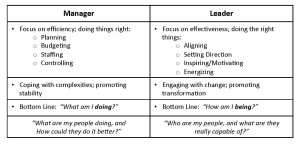An ongoing series exploring the changing nature of leading change
“The art of progress is to preserve order amid change and preserve change amid order.”
∼ Alfred North Whitehead
Both/And
More than 25 years ago, John Kotter observed that leading and managing are unique and complementary systems of action.

*Based on “What Leaders Really Do,” John P. Kotter, Harvard Business Review, May/June 1990
Over time, it has become imperative that organizations (and their leaders) be good at both. Especially in the context of change, balancing these two imperatives can seem overwhelming, tempting leaders to impose a false choice between “one or the other.” Both are critical – and especially when it comes to change, they are not really separate at all. Indeed, change leadership can be characterized as the intelligent balancing of management and leadership skills to create something new.
Letting Go Is Change
To be effective in leading change, one of your first responsibilities as a leader is to let go of any personal attachment to any outmoded management responsibilities, habits, and practices. The leadership act, here, is to use your management skills to actively drive management responsibility deeper into the organization.
Changing habits isn’t easy. After all, how did you get where you are? By demonstrating exceptional management skills. So it’s natural to feel confident, competent, and comfortable in continuing to use them. On the other hand, stretching into something entirely unfamiliar can feel entirely opposite. Is it any wonder that there is a pull toward hanging on to old ways of “managing”?
The fact is, letting go actually requires a leader’s discipline to envision what is possible, watch for instances of habitual behavior, and then consciously choose and act differently.
Before you really take on the challenges of leading organizational change, it’s important that you first do the hard work of leading yourself through your own change process:
- Getting right with reality. Acknowledging the scale of your challenges and the personal discomfort of learning – first to yourself, and then to others.
- Not worrying about appearances. Focusing on the results you need, and modeling a kind of fearlessness in tackling difficulty and targeting opportunity.
- Identifying/assembling the support you will need to persevere through time and circumstance – the people, tools, and resources that will lighten your load while making your work both more enjoyable and productive.
- Not waiting to feel 100% ready before getting started. Being alert for that moment when you feel, “ready enough,” then simply beginning – trusting that you’ll continue to learn, adapt, and grow along the way.
In the midst of your transformation, you will begin to discern which of Kotter’s “unique and complementary actions” is called for – moment-to-moment, situation-by-situation. You’ll have to learn, through direct experience, how to balance preserving “order amid change” with preserving “change amid order.” You’re developing a competency that will serve you well in any change effort.
Consider that the work of taking yourself through the hard work of personal change actually prepares you to lead others through the hard work of organizational change.
It is well worth the effort for everyone involved.
